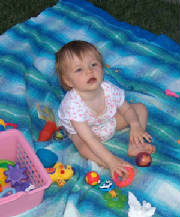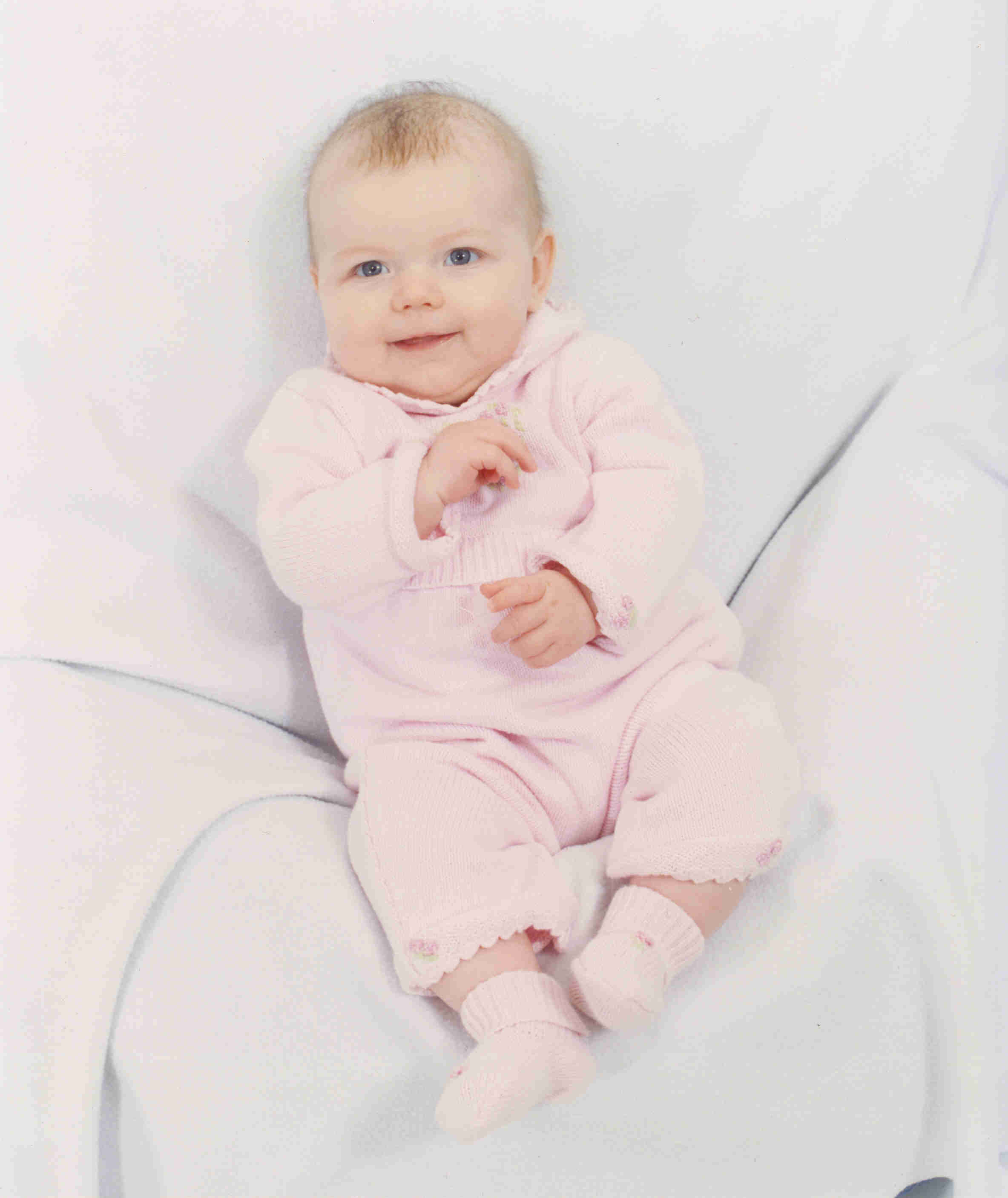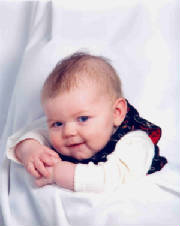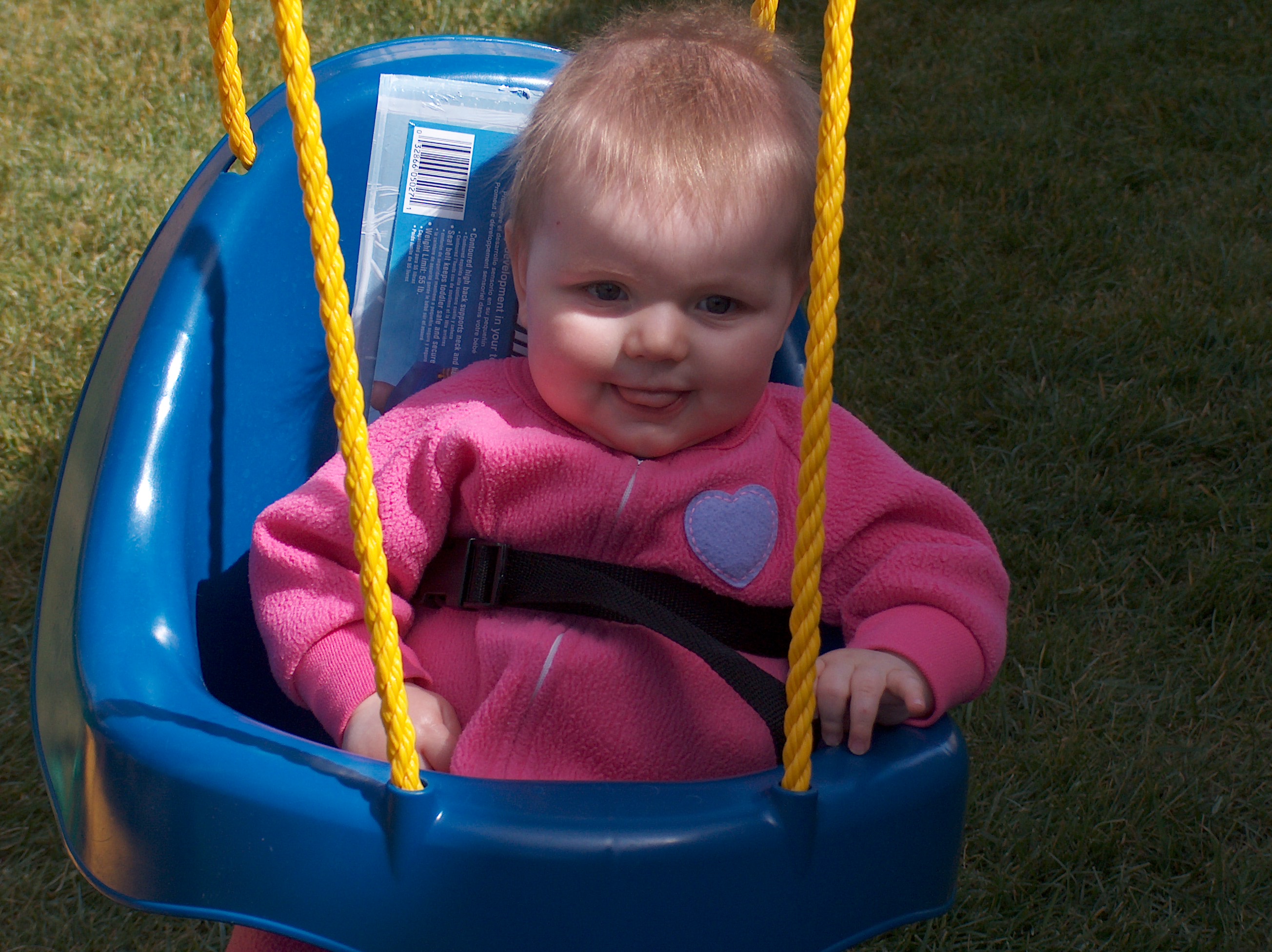 |
 |
 |
 |
 |
|
How It All Began...
Little Madison quickly entered this world on June 21, 2004.
(We were only at the hospital for a half hour before she arrived!) She was a beautiful baby with shocking black hair.
We were so happy to have our second little angel, but she was extremely colicky for her first five months, making it
a very challenging time for all of us. (Now we are wondering if that was colick after all...) Besides the
colick, though, she seemed like a perfectly healthy baby, definitely thriving and we had no concerns about her development.
She was slow to roll over, but so was our Savannah, so that didn't concern us too much.
When Madison was about eight months old and still not sitting
up on her own, we began discussing our concerns with her pediatrician. Still thinking she was in the “range-of-normal”
we all agreed that she was just a bit slow to start and would eventually start progressing.
At her nine month appointment, her pediatrician was convinced
she was still in that range, but told us just to make sure, he could refer Madison to a neurologist. My favorite quote
from him was that Madison might not be doing everything we want her to be doing, but he knew that the “lights are definitely
on in Madison’s house.” He had always been taken with her, and those words have always meant the world to
us.
At ten months old, on May 11, 2005, we met with the neurologist.
Quite honestly, we were expecting him to give us the “range of normal” line and treat us like we were neurotic,
overly-concerned parents. Much to our surprise, he said that, yes, there was definitely a problem and that our Madison
was significantly delayed. He used the term “globally delayed” which we didn’t understand at the time,
but learned later he meant she was delayed in all areas of development. This was not good news. He said she was
functioning at the level of a four to five month old. He was not rude, and said these things in the kindest way possible,
but it certainly was a shock to us. He recommended a myriad of tests, including genetic testing, a brain MRI, and hundreds
of other blood tests. This is also when he mentioned the word “hypotonic.” Having never even heard
that word before, it didn’t mean much to us at the time, but we certainly got on “WEB MD” that evening to
find out more about it. We discovered that hypotonia means that a child is born with low muscle tone. These children
tend to be very floppy, flexible and significantly developmentally delayed. That certainly was our Madison. He
also recommended that we get in touch with our local “Regional Center” to get Madison started with early intervention
physical therapy. These words were foreign to us. We had no idea what we were getting ourselves into, or the journey
we were about to embark on.
From this point on, we just had a lot of waiting to do...
We did many of the blood tests that day, and found out in about a week that most of them were coming up negative. It
also took us about a month to get a urine sample from her. Try collecting pee in a bag tucked in a diaper, and you’ll
realize this is quite a challenging task! After about 20 attempts, we finally got enough and sent it to the lab...
Meanwhile, we did get a call from the neurologist saying that we needed to get further tests done, because something
funny was coming up with her chromosomes. This was when we were referred to a genetist. She had a chromosome “translocation”
meaning that parts of two of her chromosomes had switched places with each other. This could be part of her problem,
or it could mean absolutely nothing. It is not that rare to have this.
On June 20th, 2005, the day before Madison’s first birthday,
bless her heart, we took a trip to get her MRI done. We were extremely clueless as to what this entailed. We knew
she had to be put to sleep and were counseled on that process, but we just didn’t really realize that she was being
fully admitted into the hospital. We didn’t know she’d have to get a tiny little hospital bracelet, a tiny
little hospital gown, and was going to be carted away from us in a tiny little hospital crib. We were in shock.
She was in the MRI for more than an hour, and we just waited and waited and stared at each other a lot.
She came out of her anesthesia just fine, but she was quite stoned
for the rest of the day. ;-) Trying to make light of the situation, her drugginess was actually quite adorable.
She slept and slept and slept. On that same day, later in the afternoon, we met with the geneticist. She slept
through most of the appointment and the doctor, a very kind man, had lots of questions for us and thoroughly analyzed
Madison. He had my husband and I get blood tests done, assuming that one of us must have the same chromosome-thing as
Madison. If one of us did, that would mean it was not a big deal, and not a cause of her delays.
We discovered that neither my husband nor I had this “chromosome
translocation” which just meant we were faced with a lot more unanswered questions. Madison has since been admitted
into a genetic study through Harvard so that they can study her chromosomes, and if any new discoveries are to be made about
this condition, we might get some more answers about what this means to Madison. It still could mean absolutely nothing,
and we will probably never really know. The neurologist is convinced that it must be somehow related to her condition.
So Madison did not actually ever receive a technical “diagnosis.”
She is said to have hypotonia, and to be ataxic. Ataxia means that there is not a lot of control over muscle movements.
She sometimes moves a bit randomly, with not a lot of purpose to that movement. These are not diseases, but conditions,
and usually symptoms of something else. That “something else” has not been discovered yet and in all likelihood
won’t ever be.
Meanwhile, we started going through the process of getting Madison
started in the early intervention program through our Regional Center. We had NOOO idea what a huge process this was,
and we especially didn’t know how long it would take. We found out it would be a good three months before Madison
could receive any services. Anxious to get her started, we inquired about private therapy, and we were connected to
an infant physical therapist. Unfortunately, the drive to see this therapist took about an hour and a half. So
for a few months, we had lots of travelling to do, but we were just happy to finally get something started. Within
three weeks of her first therapy session, at thirteen months old, Madison began sitting on her own, and we were just thrilled
It was either the therapy was really, really working, or it was just Madison’s time to finally sit. A whole
new world opened up for her, and she was so much happier with her new view of the world.
Over that summer after Madison was a year old, early intervention
got the ball rolling, and through many, many meetings, appointments, and paperwork, they evaluated every aspect of our dear
Maddie. By the end of July, 2005, we discovered that Madison was eligible to receive almost every service they offered.
This was very good news, but at the same time, it was a bit shocking to realize that our little girl was in need of so much
help... She would soon begin work with a physical therapist, occupational therapist, infant development specialist,
and speech therapist.
This brings us to today, November 2005. Our Maddie
is still not moving much, but is certainly trying her very very hardest to get around. She is still “just sitting”
but to see the progress in that is just amazing. Her first few months of sitting involved a lot of tipping over and
uncontrollable movements. She is now sitting strong and moving with a lot of purpose. She's trying so very hard
to crawl and we are convinced that she will be crawling all over this place some day very soon!
|
|
 |
 |
 |
 |
 |
This is not the best picture in the whole world, but it clearly, clearly displays Madison's "Hypotonia."
For quite some time, this was her normal sitting position. Her little froggy legs are still quite present, but we are
working on that in all of her therapies... (13 months old)

|
|
 |
      
 |
 |
 |
 |
|
Where Do We Go From Here?
So, needless to say, we are now quite
busy with all of this therapy. This has been a huge adjustment for our family and was extremely hard at the get-go.
It is now a part of our everyday life, and we are so extremely thankful for all of the wonderful people who are trying to
help us right now. Madison had a very hard time adjusting to all of these new people in her life, but now she just lights
up now when she sees (most of) them!
So what lies ahead? This topic is very debateable and, quite
honestly, we don’t know. Naturally, we have been doing lots of research on the subject trying to find answers.
There are not tons of kids out there who just have hypotonia with no other diagnosis. We have found some people on-line,
though, and have been reading about them. From what I learned, I am making a few predictions:
Madison will probably be just fine, but this is a very long process. She will probably be in therapy for at least
the next five years. She will crawl, walk, and talk someday. She will probably be “normal”.
But, she is probably not going to be the most athletic girl in the world, as her body is just not made to do tons of physical
activity. She fatigues extremely easy when exercising now, which is a symptom of hypotonia, and will continue to be
quite easily fatigued throughout her life. She will probably have some balance issues, and when she does learn to walk,
she will probably fall down a lot for quite some time. It will be extremely hard for her to open doors and go up and
down stairs. She will probably go to a “regular” school, though for preschool we are already debating whether
or not to put her in a “special needs” program or not. This would be primarily for safety conerns.
Madison is going to have a very hard time learning to talk. This is for a few reasons. One, the low muscle
tone is present in her mouth, tongue and cheeks. This makes it very hard to make her mouth work correctly to make sounds
and form words. Also, in order to begin speaking, in general, kids need to be reaching physical milestones, as it is
all interrelated. Lastly, because Maddie is not moving very much yet, she is just not having the same experiences as
most kids her age, therefore not having the same type of learning, exploration, opportunities, etc. This is where the
infant teacher is supposed to help us out. We are learning how to, and trying very hard to give her the same experiences
as a "typically developing" baby.
Cognitively (her brain function, that is), Madison should be just fine. We won't see all that her intelligence
has to offer right away, though, due to her physical and speech delays.
There is no cure for Hypotonia, it doesn't go away, and she will have it for her entire life. How she functions
in this world, though, depends on how well she learns to compensate for her lack of muscle tone. She can increase her
muscle strength but she will never be able to increase her muscle tone. This is why all of this
therapy so early in her life is extremely critical. If she learns how to compensate now, it will
make it much easier for her to do so in the future.

|
| Our beautiful girl at 5 months old |
We have definitely learned to embrace Madison’s condition.
We are working on developing a full acceptance of it, and I don’t think that is far off. This is a part of who
she is, and I find it adorable. We love the fact that she always looks so darned relaxed and laid-back. We love
the fact that she is so flexible and nimble; it’s actually quite amazing We love the fact that she is the
most cuddly baby in the whole world and just melts into our arms, not trying to race away from us. She is who she is,
and this is part of it, so we wouldn’t change it for the world!

|
| Maddie at 6 months old |
|
|
 |
 |
 |
 |
|

